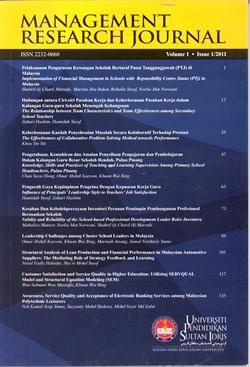An Extra-curricular activities extension in public elementary schools
Keywords:
Extra-Curricular Activities, Academic Performance, Teachers, Implementation, PerformanceAbstract
The main purpose of this study is to determine the extent of implementation and level of contribution of the extra–curricular activities in the public elementary schools. Descriptive research was utilized in this study. There were 7 school heads and 64 selected teachers as respondents using total enumeration technique. Information was obtained from the respondents through the use of questionnaires. Quantitative data collected by using a questionnaire were analyzed by the use of descriptive statistics and presented through percentages, means, and frequencies. Findings show that there is an over- all high implementation of the extra-curricular activities in the public elementary school of Aguinaldo District 2. Moreover, pupils have active participation of the different activities through the leadership of the school administrators and teachers. Likewise, the school heads and teachers treat extracurricular activities with similar passion with the curricular activities but with careful discretion in not disrupting regular class schedule. The study also shows that extra-curricular activities can provide better environment for the development of school especially on the nurturing of the pupils. Pupils of the public elementary schools in Aguinaldo District 2 have been actively competing in the different extra-curricular activities which made each school able receive awards in different levels. The success of the school performances requires careful management and good organization. Therefore, support, cooperation and motivation from school administrators, parents and students should necessary in order to maintain excellence achievement and good school performances.
Downloads
References
Annamalai, J.T., Darling, N., Caldwell, L., &Smith, R. (2012). Participation in school-based extracurricular activities and adolescent adjustment. Journal of Leisure Research, 37(1),51-76.
Astin, A. (2009). What matters in college? Four critical years revisited. San Francisco: Jossey-Bass
Bartkus, L. M. & Lee, T.W. (2012). Under-represented college students and extracurricular involvement: the effects of various student organizations on academic performance Soc Psychol Educ (2012) 11:273–298. DOI 10.1007/s11218-007-9050-y. Springer Science+Business Media B.V.
Chen, X., Choy, S., Chandler, K., Chapman, C., Rand, M. & Ringel, C. (2007) Effective Leadership. Journal on Educational Management.
Cole, J. J. Holland, J.L. & Trillis, K.D. (2007). Extracurricular activities and adolescent development. Journal of Social Issues, 59(4), 865-889.
Broh, J. K. (2002). Self-perceptions and participation in extracurricular physical activities. The Physical Educator, 60(2), 13-19.
Emmer. H.T. (2010). The Relationship of Participation in Extracurricular Activities to student Achievement, Student Attendance, ands Student Behavior in a Nebraska School District, Pro Quest LLC, Ed. D. Dissertation, p67.
Holloway, John H. (2002). Extracurricular Activities and Student Motivation. Journal on Educational Leadership. 60 (2002): 80-82.
Holloway, J. (January, 2002). Extracurricular Activities: The Path to Academic Success? Educational Leadership. 57(4), 87-88. Retrieved from http://www.ascd.org/publications/educational-leadership/dec99/vol57/num04/-Extracurricular-Activities@-ThePath-to-Academic-Success%C2%A2.aspx.
Lunenburg, F. C., & Ornstein, A. O. (2008). Educational administration: Concepts and practices (5th ed.). Belmont, CA: Wadsworth/Cengage Learning.
Griffiti, J.L. (2014). The Effects of Student Activity Participation, Gender, Ethnicity, and Socioeconomic Level on High School student Grade Point Averages and Attendance. National Association of African American Studies & National Association of Hispanic and Latino Studies.
Ministry of Education Malaysia. (2006), Extracurricular Guidelines, Kuala Lumpur
Mohd Sofian, O.F., Amir,Y.(2006). Importance and Activities of School Extracurricular. Shah Alam. Penerbit Karisma Publications Sdn. Bhd.
Reeves, D. B. (2008). The extracurricular advantage. Journal on Education Leadership, 86-87.
Reynes, K.L & Silliker, S. A. (2003). The effect of extracurricular activity participation on the academic performance of male and female high school students. School Counselor, 44(4), n.p.
Olson, R.A. (2008). Relationships of Student Behaviors with Class Percentile Rank of Iowa High School Seniors. (Doctoral dissertation, Drake University, 1990). Dissertation Abstracts International, 50: 1881-1882
Shulruf, B., Tumen, S, & Tolley, H. (2010). Extracurricular activities in school, do they matter? Children and Youth Services Review, 30(4), 418-426.
Smith R (2015). Participation in school-based extracurricular activities and adolescent adjustment. J. Leisure Res., 37, 51-77.
Smith, R. (2005). Participation in school-based extracurricular activities and adolescent adjustment. Journal of Leisure Research, 37(1),51-76.
Stoltzfus, C. D. (2007). A Study of the Correlation Between Participation in Extracurricular Activities and Academic Performance of Middle Level and High School Students. MA paper The Pennsylvania State University.
Walter, E.H. (2006). Extracurricular work in action (Sports). Kuala Lumpur: Fajar Bakti Sdn. Bhd.
Yahya Don, L.K., Ford, H.I. & Steel, H.G. (2014). Roles, Tasks and Responsibilities of School Teachers. Kuala Lumpur: Utusan Publication & Distributors Sdn. Bhd.





